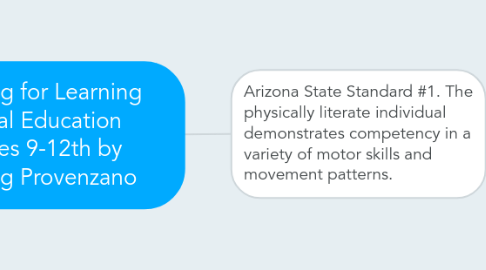
1. Arizona State Standard #1. The physically literate individual demonstrates competency in a variety of motor skills and movement patterns.
1.1. Objective: SWBAT: Identify how to increase motor skills and use muscle movement of Arms, Legs, Feet and entire Body.
1.1.1. Big Idea: Students must know the essential motor skills and movement patterns: Walking, Jumping, sprinting, push, pull, lung, twist, bend and a combination.
1.1.1.1. Scaffolding Strategies: Fish bowl- small student group- teach, Visual movement charts, show and tell, Pre-teach vocab.
1.1.1.1.1. Key Factors about students: The pre-teach vocab allows the students to hear hear aloud the terminology for the lesson along with the show and tell for different learning styles and readiness levels. I can evaluate the different ability levels of the students by using the fish bowl and group teaching. This also helps the students learn by example and allows them to see the movement patterns and then proceed to do them on their own. The ELLs can learn by the visual movement charts displayed also.
1.2. Objective: SWBAT: Learn fitness activities that are specific for the goal of the individual, along with training principles, tactics and strategies to improve.
1.2.1. Big Idea: Students will identify specific fitness activities. They will set specific goals for themselves and find the best tactics to train and learn strategies to assist them the best. They will explore ways to improve and reach higher levels individually.
1.2.1.1. Scaffolding Strategies: Sentence Structure starters to learn how to set goals. Visual teaching videos for training tactic ideas and motivation. Think/pair and share in a structured time to discuss strategy ideas. Tap into prior knowledge in class discussion to relate an activity to their lives. Personal White boards.
1.2.1.1.1. Key Factors about students: The sentence starters will prepare the students at all levels of readiness on how to set goals. This is helpful for those that have not prepared goals prior because part of the sentence will be written for them. Also, for anyone that has advanced knowledge in setting goals, this works because they have fill in the text left blank, requiring them to use their own thought process and be creative. The video allows all learners to see an example to prepare for the activity. Think/pair and share fitness activities and tactics allows students with less knowledge to see/hear examples to learn and I can move about the room to help others that need help with ideas and strategies. The white boards will be there to write down their brainstorming ideas for activities & improvement notes.
1.3. Objective: SWBAT: Produce a practice plan to improve performance for your favorite sport or skill that relates to you
1.3.1. Big Idea: Students to apply the knowledge they have learned and use the skills with their own bodies to perform activities properly and consistently.
1.3.1.1. Scaffolding Strategies: Graphic Organizers, Mind Mapping and small group/partner work.
1.3.1.1.1. Key Factors: Individual work with a graphic organizer helps the students put together their brainstorming ideas and any prior knowledge they have to organize their thoughts to make a plan of activities. There is no write or wrong way to write ideas for learning ability styles. Once they have started at least three ideas on the mind map, they will pair up in small groups to decide on plan to improve performance and how the plan will begin, improve their bodies and end. The "intentional" small groups will be geared towards different ability levels and language styles that compliment each-other at a similar stage.
1.4. Objective: SWBAT: Analyze and evaluate an action plan
1.4.1. Big idea: Students will review and analyze their action plans to see if it was successful and what they may be able to do to improve it for higher learning.
1.4.1.1. Scaffolding Strategies: Tap into Prior knowledge, Praise and encourage, monitor progress and show and tell and model gestures.
1.4.1.1.1. Key Factors: Tiering visual worksheet are offered for students less ready to analyze with guides and questions to critique their own work in class or at home. Adaptable as needed. Show and tell for different learning styles to example the outcome of their plans and what worked or didn't. Praise and encouraging students as they offer ideas gives confidence and assurance. As partners they will give each other ways to improve their own work.
